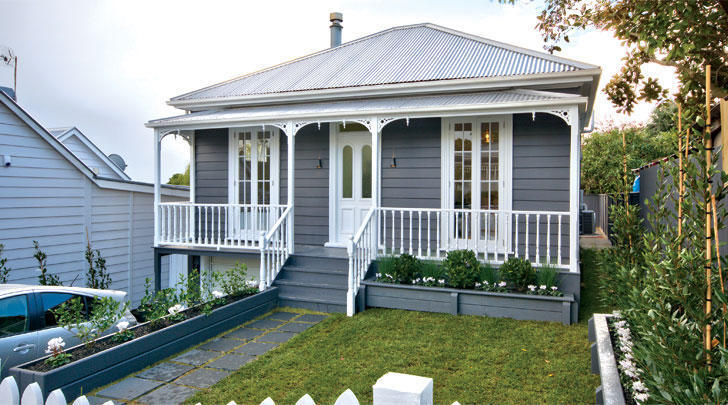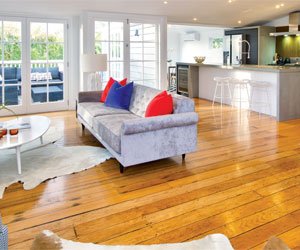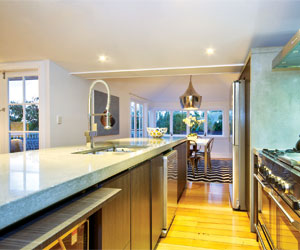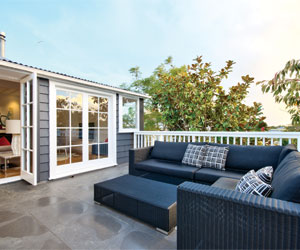Building and renovation
The ventilated villa
Green Ideas editor Greg Roughan

[This story first appeared in the Aug-Sep 2014 issue of Green Ideas magazine]
A renovation project in Auckland focused on better air and insulation, rather than the typical indoor-outdoor flow.
Address: 45 Lincoln Street, Ponsonby, Auckland
Bathrooms: 2
Bedrooms: 4
Off-street parking: 2 cars
Land area: 306m2
Floor area: 187m2
CV: $980,000 (at time of publication, Aug 2014)

When Krista Strong decided to renovate her historic Auckland villa, she discovered that bringing a century-old home up to modern standards without ruining its character was a special kind of challenge.
Wooden villas are one of the classic New Zealand house styles. Built from the 1880s up until the early 1900s, they typically feature weatherboard exteriors and ornate fretwork, and often used native timbers that are largely unavailable today.
However anyone who has lived in a villa will also know they are notoriously draughty, often damp, and tend to give the cold shoulder to natural assets like sunlight.
Krista wanted to do up her home before selling it, so her plan was to add value by creating a modern living environment – ie. one that was warm and dry (and therefore healthy and energy efficient) – while retaining her home’s classic appeal.
With this in mind she opted to use wooden frames on any new doors and windows. However she decided against double glazing due to the extra cost, which in turn left an unsolved issue: without double-glazing the home would still be prone to that bane of old houses, weeping windows, and the mould and rot they can cause.

Ventilate as you renovate
The answer for Krista lay in an extensive ventilation system fit-out. Thanks to some handy contacts in the advertising industry, she was able to strike a unique deal with ventilation experts HRV: they would donate their systems in return for the property being used as a kind of show home during the sales process. HRV also brought several other companies into the arrangement: Toshiba provided heat pumps, Mercury Energy gave a free year of power and a GEM monitoring system, and so on.
The end result was a top-to-toe approach to air quality, warmth and energy efficiency, all at minimal cost to Krista.
Today an HRV system in the roof has made morning moisture on the windows a thing of the past. In cool weather a heat transfer unit pulls air from each room through unobtrusive ceiling vents, strips out dust and moisture, uses the trapped heat of the roof space to warm it, then returns it to the living spaces. In hot weather a summer system takes over, using cool external air to regulate the temperature inside.
However the ventilation systems deal primarily with moisture, so the donkey work of controlling temperature falls to three heat pumps – two upstairs and one down – plus electric wall heaters in the smaller rooms. While that may sound like overkill for a small home, their workload is minimised thanks to extensive insulation by GreenStuf, which includes acoustic dampening in the bathroom and bedroom walls.

Minimal floor-plan change
It didn’t actually take much to modernise the interior of the home. While the house is more than a century old, it had been altered before. In 1984 a boat-builder owner had it lifted and set back from the road to create a workspace that is now the garage, and internal walls had been removed to open up the rear living spaces. So Krista simply shuffled a rear-wall kitchen to one side, which allowed her to open the (north-facing) back of the building to the sun and air with an extra set of French doors.
Meanwhile, the old top-floor master bedroom became a dining area, and the master bedroom moved into the downstairs space – which thanks to the heating and ventilation systems is now warm, snug and dry, rather than cool, damp and claustrophobic.
A fit-out with energy-efficient LED lights, and a lick of VOC-free, hypoallergenic paint from Resene later, and the house – modernised, yet still traditional – is now ready for its new owners.
Renovate or rebuild?
Renovating is almost always a greener choice than rebuilding. Building from new is very energy-intensive, and creates a lot of waste – whereas renovating allows you to reuse old materials, while reducing day-to-day energy use with better insulation and modern heating.
